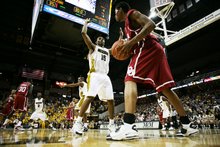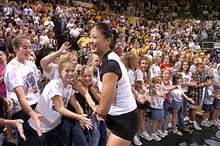So I thought I'd try something new here for the 2 nerds who actually read these 'Beyond the Box Score' bits. Since I've entered all the play-by-plays for MU and NU, I thought I'd try to pinpoint some advantages and disadvantages by looking at the categories on which I base my Beyond the Box Score post-game posts. Just makes you a-twitter with anticipation, doesn't it?
Success Rate by Quarter
Missouri (all plays)
Q1 – Missouri 48.8%, Opponents 39.7%
Q2 – Opponents 54.3%, Missouri 51.7%
Q3 – Opponents 52.4%, Missouri 51.3%
Q4 – Missouri 50.0%, Opponents 50.0%
TOTAL – Missouri 50.5%, Opponents 49.8%
Nebraska (all plays)
Q1 – Nebraska 48.2%, Opponents 41.0%
Q2 – Nebraska 53.6%, Opponents 43.8%
Q3 – Nebraska 54.9%, Opponents 42.2%
Q4 – Nebraska 51.4%, Opponents 44.7%
TOTAL – Nebraska 52.1%, Opponents 43.0%
This looks like Nebraska has the edge here until you take out the plays made when the game wasn’t close (i.e. within 16 points or less).
Missouri (close)
Q1 – Missouri 48.8%, Opponents 39.7%
Q2 – Missouri 54.9%, Opponents 44.4%
Q3 – Missouri 65.6%, Opponents 52.4%
Q4 – Missouri 40.9%, Opponents 37.5%
TOTAL – Missouri 51.5%, Opponents 42.1%
Nebraska (close)
Q1 – Nebraska 48.2%, Opponents 41.0%
Q2 – Nebraska 53.6%, Opponents 43.8%
Q3 – Nebraska 53.8%, Opponents 40.3%
Q4 – Nebraska 46.8%, Opponents 46.7%
TOTAL – Nebraska 51.0%, Opponents 42.6%
Other than the fact that NU plays better than Missouri does when the game's not close (which makes sense considering Callahan kept his starters in against USC's third string to make the final score look closer than it was a couple weeks ago), it’s striking to see not only how close the overall numbers are (Missouri is +9.4%, Nebraska +8.4%), but how the game seems to flow the same by quarter.
-- In Q1, MU is +9.1%, NU +7.2.
-- In Q2, MU is +10.5%, NU is +9.8%.
-- Q3 is where the movement takes place—in Q3, MU is +13.2%, NU is +13.5%.
-- In Q4, MU is +3.4%, NU is +0.1%.
What does this mean? Not sure...could mean a lot of things, I guess (sparkling analysis!), but chances are that it means the team who gets off to the more efficient start could be able to dictate the action throughout. Since Memorial Stadium will be pretty psychotic at kickoff, that might say good things about Missouri’s chances.
QB Success Rate
As always, this only looks at when the game was within two possessions.
Missouri
Chase Daniel – 119 for 229 (52.0%)
Chase Patton – 0 for 1 (0.0%)
TOTAL – 119 for 230 (51.7%)
Nebraska
Sam Keller – 151 for 293 (51.5%)
Even though Keller and Daniel run distinctly different offenses, they run them with almost identical rates of success. Daniel ranks much higher on most lists simply because a lot of Mizzou’s numbers come from passing, while NU is content to run a ton if you’ll let them. The main difference between them, I think, is their propensity for responding to pressure. That comes mostly in sack rate and in turnovers, both of which we’ll discuss in detail later.
Run Success Rate
Missouri
Earl Goldsmith – 1 for 1 (100.0%)
Chase Daniel – 9 for 18 (50.0%)
Jeremy Maclin – 6 for 8 (75.0%)
Martin Rucker – 3 for 5 (60.0%)
Marcus Woods – 2 for 4 (50.0%)
Derrick Washington – 1 for 2 (50.0%)
Tony Temple – 20 for 47 (42.6%)
Jimmy Jackson – 1 for 5 (20.0%)
TOTAL – 43 for 90 (47.8%)
TOTAL, RB’s – 25 for 59 (42.4%)
TOTAL, QB’s – 9 for 18 (50.0%)
TOTAL, WR/TE’s – 9 for 13 (69.2%)
Nebraska
Quentin Castille – 15 for 26 (57.7%)
Cody Glenn – 5 for 9 (55.6%)
Marlon Lucky – 50 for 97 (51.5%)
Roy Helu – 2 for 4 (50.0%)
Sam Keller – 1 for 7 (14.3%)
Terrence Nunn – 0 for 2 (0.0%)
TOTAL – 73 for 145 (50.3%)
TOTAL, RB’s – 72 for 136 (52.9%)
TOTAL, QB’s – 1 for 7 (14.3%)
TOTAL, WR’s – 0 for 2 (0.0%)
In the last three games since Illinois, Temple (17 for 30 (56.7%)) and Daniel (7 for 9 (77.8%)) have seen their numbers skyrocket, but I still give the advantage to Nebraska here. Missouri lines up in more formations, and they set up quite a few direct-snap situations for Maclin, Temple, Rucker, etc., but I don’t think there’s any disagreeing with the fact that NU’s running game is more proven at this stage in the game.
Receiver Success Rate
Missouri
Greg Bracey – 1 for 1 (100.0%)
Jason Ray – 1 for 1 (100.0%)
Derrick Washington – 1 for 1 (100.0%)
Chase Coffman – 13 for 14 (92.9%)
Jeremy Maclin – 14 for 16 (87.5%)
Tommy Saunders – 6 for 7 (85.7%)
Will Franklin – 12 for 15 (80.0%)
Martin Rucker – 17 for 22 (77.3%)
Jared Perry – 3 for 4 (75.0%)
Tony Temple – 2 for 3 (66.7%)
Danario Alexander – 5 for 9 (55.6%)
Jimmy Jackson – 1 for 2 (50.0%)
TOTAL – 76 for 95 (80.0%)
TOTAL, WR’s – 42 for 53 (79.2%)
TOTAL, TE’s – 30 for 36 (83.3%)
TOTAL, RB’s – 4 for 6 (66.7%)
Nebraska
Nate Swift – 14 for 14 (100.0%)
Cody Glenn (RB) – 2 for 2 (100.0%)
Thomas Lawson (FB) – 2 for 2 (100.0%)
J.B. Phillips (TE) – 1 for 1 (100.0%)
Dan Erickson – 1 for 1 (100.0%)
Quentin Castille (RB) – 1 for 1 (100.0%)
Roy Helu (RB) – 1 for 1 (100.0%)
Maurice Purify – 14 for 15 (93.3%)
Terrence Nunn – 13 for 15 (86.7%)
Sean Hill (TE) – 6 for 7 (85.7%)
Frantz Hardy – 4 for 5 (80.0%)
Hunter Teafatiller (TE) – 2 for 3 (66.7%)
Todd Peterson – 3 for 5 (60.0%)
Marlon Lucky (RB) – 14 for 24 (58.3%)
TOTAL – 78 for 96 (81.3%)
TOTAL, WR’s – 49 for 55 (89.1%)
TOTAL, TE’s – 9 for 11 (81.8%)
TOTAL, RB’s – 20 for 30 (66.7%)
A lot of the difference in numbers here comes from different offensive philosophies. NU rarely throws short to their WR’s, instead dumping off to their RB’s 4x more than Mizzou (6.0 per game to MU’s 1.5). Meanwhile, both teams’ TE’s are used effectively...the glaring difference, of course, being that Mizzou’s TE’s catch 9 passes per game (with the score within 16 points), while NU’s catch just 2.2 passes per game.
The wildcard here, of course, is that Maurice Purify might not play Saturday since he is in California awaiting the funeral of his girlfriend, who died in a car accident last weekend. Even if he does play, there’s no telling where his mind will be, as he was still recovering from the loss of his brother about a month ago. That’s as swift a reminder that there’s more to life than football if I ever saw one.
Line Yards and Sack Rate (OFFENSE)
In my line stats discussion from a couple weeks ago, I looked at Line Yards and Sack Rates to get a decent analysis of lineplay. Until something better comes along, that’s what I’ll continue to use.
LINE YARDS
Missouri
2007 Missouri average: 3.09 yds/carry (91 carries, 281.6 yards)
2006 Missouri average (in conference): 2.77 yds/carry
2006 Big 12 average: 2.86 yds/carry
Nebraska
2007 Nebraska average: 2.63 yds/carry (148 carries, 389.3 yards)
2006 Nebraska average (in conference): 3.15 yds/carry
2006 Big 12 average: 2.86 yds/carry
SACK RATE (FIRST & SECOND DOWNS)
Missouri
2007 Missouri rate: 0.9% (1 sack, 106 attempts)
2006 Missouri rate (in conference): 4.6%
2006 Big 12 rate: 5.5%
Nebraska
2007 Nebraska rate: 1.9% (2 sacks, 108 attempts)
2006 Nebraska rate (in conference): 8.2%
2006 Big 12 rate: 5.5%
These numbers will almost certainly go up as conference season progresses, but give Mizzou the edge so far.
SACK RATE (THIRD & FOURTH DOWNS)
Missouri
2007 Missouri rate: 3.0% (1 sack, 33 attempts)
2006 Missouri rate (in conference): 5.2%
2006 Big 12 rate: 8.1%
Nebraska
2007 Nebraska rate: 5.0% (2 sacks, 40 attempts)
2006 Nebraska rate (in conference): 8.9%
2006 Big 12 rate: 8.1%
This surprised me a bit, simply because when I’ve seen Sam Keller play, he’s always seemed to freeze up a bit when someone gets some pressure on him. More often than not, he seems to rush his delivery and throw a pretty inaccurate ball...but I still thought he was getting sacked more than this. Either way, though, Missouri has a slight advantage in all O-line categories. Some of that can be explained by the schedule (Illinois’ D-line is good, but it’s safe to say that USC’s is better), but not all of it.
Line Yards and Sack Rate (DEFENSE)
LINE YARDS
Missouri
2007 Missouri average: 3.10 yds/carry (72 carries, 223.4 yards)
2006 Missouri average (in conference): 3.19 yds/carry
2006 Big 12 average: 2.86 yds/carry
Nebraska
2007 Nebraska average: 2.60 yds/carry (154 carries, 401 yards)
2006 Nebraska average (in conference): 2.59 yds/carry
2006 Big 12 average: 2.86 yds/carry
SACK RATE (FIRST & SECOND DOWNS)
Missouri
2007 Missouri rate: 6.7%
2006 Missouri rate (in conference): 7.8%
2006 Big 12 rate: 5.5%
Nebraska
2007 Nebraska rate: 4.4%
2006 Nebraska rate (in conference): 3.7%
2006 Big 12 rate: 5.5%
SACK RATE (THIRD & FOURTH DOWNS)
Missouri
2007 Missouri rate: 3.1%
2006 Missouri rate (in conference): 9.8%
2006 Big 12 rate: 8.1%
Nebraska
2007 Nebraska rate: 0.0%
2006 Nebraska rate (in conference): 9.3%
2006 Big 12 rate: 8.1%
I was going to use this as evidence that Missouri has been holding back in the blitz department—you’re not supposed to have a worse sack rate on third downs (a blitzing down) than you do on first and second. However...what’s Nebraska’s excuse? Playing a team like USC, they had no reason to keep some tricks up their sleeves in anticipation of the Missouri game. In close games, they have yet to record a sack on third or fourth down...something made even more astounding considering they played Bret “I get sacked every other time I drop back to pass” Meyer last week, and the game was actually close for a while. This does somewhat explain how Ball State racked up 400 passing yards on them.
Hmm...Missouri's leading the nation in third down efficiency...Nebraska doesn't sack QBs on third down...hmm...
Defensive Success Rate
MISSOURI
Defensive Line
Leader: Lorenzo Williams – 9.0 tackles, 9.0 successful (100.0%)
TOTAL – 25.5 tackles, 17.5 successful (68.6%) (2006 Big 12 average: 71.4%)
Linebackers
Leader: Brock Christopher – 16.5 tackles, 11.0 successful (66.7%)
TOTAL – 37.5 tackles, 21.5 successful (57.3%) (2006 Big 12 average: 57.1%)
Defensive Backs
Leader: Pig Brown – 15.5 tackles, 6.0 successful (38.7%)
TOTAL – 56.0 tackles, 15.0 successful (26.8%) (2006 Big 12 average: 28.2%)
% of plays made by...
Defensive Line: 25.5 of 119.0 (21.4%) (2006 Big 12 average: 26.0%)
Linebackers: 37.5 of 119.0 (31.5%) (2006 Big 12 average: 33.1%)
Defensive Backs: 56.0 of 119.0 (47.1%) (2006 Big 12 average: 40.9%)
NEBRASKA
Defensive Line
Leader: Ndamukong Suh – 15.5 tackles, 13.0 successful (83.9%)
TOTAL – 52.5 tackles, 39.5 successful (75.2%) (2006 Big 12 average: 71.4%)
Linebackers
Leader: Corey McKeon – 15.5 tackles, 10.5 successful (67.7%)
TOTAL – 78.5 tackles, 44 successful (56.1%) (2006 Big 12 average: 57.1%)
Defensive Backs
Leader: Larry Asante – 16.5 tackles, 5.5 successful (33.3%)
TOTAL – 63.5 tackles, 15.0 successful (23.6%) (2006 Big 12 average: 28.2%)
% of plays made by...
Defensive Line: 52.5 of 194.5 (27.0%) (2006 Big 12 average: 26.0%)
Linebackers: 78.5 of 194.5 (40.4%) (2006 Big 12 average: 33.1%)
Defensive Backs: 63.5 of 194.5 (32.6%) (2006 Big 12 average: 40.9%)
For the 2006 Big 12 games I compiled, I’ve begun to compare some of these ‘success rates’ to actual success, i.e. wins, total yards, points, etc. I was wondering if it was more important for a unit like the D-line to be making plays, period, or if it was more important that they have a high success rate. I suspected, too, that you could tell a lot by what % of plays the secondary is forced to make. While that was somewhat important, by far the biggest indicator of success was Defensive Line success rate. To this extent, players like MU’s Zo Williams and NU’s Ndamukong Suh have been playing as well as you can play—Williams averaging 2.3 ‘successful’ plays a game and Suh averaging 2.6.
As a whole, however, Mizzou’s D-line has failed to make a strong level of successful plays—their 68.6% rate is too low, especially compared to NU’s 75.2%. However, anybody who watched the NU-USC game knows why we assume these stats tell the whole story. NU’s D-line repeatedly got blown up, leading to lanes so big that The Beef or I could have run for 100 yards against the Blackshirts.
In other words, neither D-line has been, shall we say, overly effective so far.
The other main problem for these two teams is that their secondaries have not made enough strong plays either...aside from the turnover department anyway. Which leads us to...
Turnover Costliness
For this stat, I’m looking at all turnovers period, not just those taking place when the game is close. And once again, here is how I measure “costliness” (also once again: if you can think of something more effective, please pass it along):
• Field position: 3 points if the turnover took place between the goal line and the 20, 2 points between the 20 and the 40, 1 point between the 40s.
• Game status: 2 points if the game was within 16 points or less, 1 if it was within 24 points of less, 0 if the margin was higher than that.
So...
Missouri
Offense: 7 turnovers, 23 total points = 3.29 average
Defense: 11 takeaways, 39 total points = 3.55 average
So they’re +4 on turnover margin and +16 on turnover costliness.
Nebraska
Offense: 12 turnovers, 45 points = 3.75 average
Defense: 10 takeaways, 37 points = 3.70 average
So they’re -2 on turnover margin and -8 on turnover costliness.
In all, Missouri turns the ball over less than Nebraska, and their T/O’s are less costly overall. They also force more turnovers than Nebraska, but thanks to Bo Ruud’s 2 INT’s for TD, NU’s takeaways are worth a little more.
Statistical MIPs
Two of the main themes that are emerging here are third downs and turnovers. You could say that pretty much every game is decided by third downs and turnovers, but it appears to be even more true here. With that in mind, here are the MIPs (Most Important Players...not Minors in Possession) for Saturday:
Missouri Offense: Chase Daniel. Duh. He's held onto the ball a bit too long and forced some passes a bit too tightly into traffic the last two games, and while my theory on that has simply been that he was testing his limits...re-learning what he can and can't do...he needs to be on his game Saturday. If he's making quick decisions and not forcing throws into traffic, MU should throw the ball at will.
Missouri Defense: I'm going to say Sean Weatherspoon. If we have indeed been holding back in the blitz department, then I'd say Weatherspoon is the most likely weapon to be unleashed Saturday. If we get pressure on Keller on third downs (without letting Marlon Lucky wander unabated into the flat for screen pass after screen pass), then the game is ours.
Nebraska Offense: Marlon Lucky. Nate Swift has been the secret weapon, but Marlon Lucky makes or breaks the offense. In just five games, Lucky has touched the ball 121 times with the score within two possessions, 97 on the ground and 24 in the air. He's been getting the tough, when-necessary yards, and if he's not allowed to make an impact in the game, then NU's toast.
Nebraska Defense: Bo Ruud. He is the defense's biggest playmaker. He disappears for series at a time, then he pops up to make back-to-back hits or, in the case of the last two games, score on a pick six. Plus, he had a huge deflected INT of Chase Daniel last year as Mizzou was beginning to put the pieces together offensively. He is the biggest potential disrupting force on the NU D.
Tuesday, October 2, 2007
Mizzou-Nebraska: Beyond the Box Score Preview
Posted by
The Boy
at
7:39 PM
![]()
Labels: Beyond the Box Score, Mizzou football
Subscribe to:
Comment Feed (RSS)






|